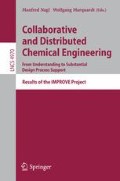Abstract
The number of employees working exclusively with computers increased almost 20 percent within the last four years. In technical offices and in the field of research and development the largest amount, 94 percent, can be found. Hence the focal point of the research project was composed of the development and prototypical implementation of software tools for the support of the work of process development engineers. This field of application provides a large range of innovative computer support because of its high amount of creative work processes hardly to support by strictly structured software tools. Additionally the exploration of many design alternatives and weakly structured constraints between different activities with unexpected or planned iterations can scarcely supported in a conventional way. For this research objective several specialized applications were developed and the ergonomics of their user interfaces were evaluated. These application specific evaluation methods form the groundwork for the redesign based on the design recommendations.
The following section describes the foundations of software ergonomics with corresponding international norms. It will also be shown, that software ergonomics knowledge alone, however, is not sufficient in order to be able to assess the quality of the software support. So the well known ergonomic requirements were supplemented by methods for work analysis. In general, the support of creative and communicative work processes requires a detailed analysis of necessary activities, organizational structure, and information flow including the identification of organizational bottlenecks. The basis for the conducted evaluation of work thus constitute three different models of work analysis which are introduced and discussed.
A suitable procedure was presented, not only for the development of evaluation criteria, but also for application scenarios for the following evaluation of subjects. The scenarios will be briefly described, and the results of the various evaluations of subjects will be introduced. These findings show the quality of the developed prototypes in terms of their area of application and give recommendations for possible improvements.
Access this chapter
Tax calculation will be finalised at checkout
Purchases are for personal use only
Preview
Unable to display preview. Download preview PDF.
Editor information
Rights and permissions
Copyright information
© 2008 Springer-Verlag Berlin Heidelberg
About this chapter
Cite this chapter
Foltz, C., Schneider, N., Kausch, B., Wolf, M., Schlick, C., Luczak, H. (2008). Usability Engineering. In: Nagl, M., Marquardt, W. (eds) Collaborative and Distributed Chemical Engineering. From Understanding to Substantial Design Process Support. Lecture Notes in Computer Science, vol 4970. Springer, Berlin, Heidelberg. https://doi.org/10.1007/978-3-540-70552-9_21
Download citation
DOI: https://doi.org/10.1007/978-3-540-70552-9_21
Publisher Name: Springer, Berlin, Heidelberg
Print ISBN: 978-3-540-70551-2
Online ISBN: 978-3-540-70552-9
eBook Packages: Computer ScienceComputer Science (R0)

